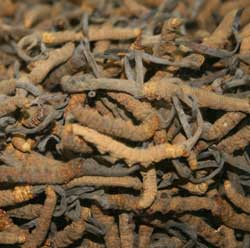 By Steven Horne and Paula Perretty
By Steven Horne and Paula Perretty
In 1993, the Chinese women’s track team beat nine world records. Their secret was cordyceps, a very unusual remedy from traditional Chinese medicine.
Cordyceps is a fungus that grows on the larvae of a caterpillar. While the caterpillar is hibernating underground, the fungus invades the organism and consumes the bug. The result is a caterpillar shaped mushroom. In the spring, it puts up a stem-like shoot, which gives the herb its Chinese name—dong chong xia cao. Literally translated this means, “winter bug, summer grass.”
Wild cordyceps grows only in high altitude environments in southwestern China, Nepal and Tibet and in isolated localities in Norway, Finland and Sweden. The wildcrafted herb is rare and expensive, but a modern process has been developed to grow the fungus in a commercial manner, making the supplement more available and affordable.
Cordyceps is an energy tonic in Chinese medicine that balances both the yin and the yang energy. This means it can be taken by just about anyone. It particularly supports the Chinese kidney (water energy) and lung (metal energy).
The Chinese kidney system includes aspects of adrenal function, because it relates to basic energy and stamina. There is also an aspect of reproductive function in the Chinese kidney system. Cordyceps helps in all these areas. It increases energy, improves stamina and can overcome sexual dysfunction.
Cordyceps reduces levels of toxic waste products produced in the body during exercise, which helps the body perform more efficiently. In one study, mice who were given cordyceps tea were able to increase their swimming time from 75 to 90 minutes.
Cordyceps has been shown to stimulate testosterone production in laboratory animals. In another study, it increased a type of estrogen essential to fertility. This correlates with its Chinese reputation as a tonic for sexual weakness and reduced libido.
The lung or metal energy in the Chinese system relates to the immune function in Western medicine. Cordyceps enhances the ability of the body to prevent and fight infection. It is a helpful tonic for people who have weak lungs and are constantly getting sick.
One benefit of cordyceps to the respiratory system is its ability to reduce inflammation in the lungs. This makes it beneficial for people with asthma, a use that has been confirmed with animal studies. It has also been beneficial for people with chronic obstructive pulmonary disease. Improvements in symptoms such as shortness of breath, cough, loss of appetite and low energy have been reported.
Another area where cordyceps offers potential health benefits is the cardiovascular system. It has antioxidant properties and has been shown to lower cholesterol and blood pressure in laboratory animals. In one study, a dose of three to four grams (about six to eight capsules) proved beneficial for 64 patients with chronic heart disease.
Studies also suggest cordyceps may be helpful for systemic lupus, liver fibrosis and hepatitis B patients. It appears to have a liver-protecting effect. It may also lower blood sugar and increase insulin sensitivity. In addition, the fungus may enhance chemotherapy and reduce blood vessel growth to the tumors.
Cordyceps is a good remedy for the elderly. Doses of just three grams per day (about 6 capsules) have resulted in improvements in energy, libido, memory, tolerance to cold, and reductions in dizziness, tinnitus and nighttime urination.
A typical dose for enhancing respiratory or immune function would be 2-3 capsules three times daily. It is a major ingredient in Immune Stimulator. Cordyceps appears to be very safe; there are no known side effects or drug interactions.
For additional information on cordyceps, consult the Secrets of Chinese Herbs course by K.P. Khalsa and Steven Horne.

